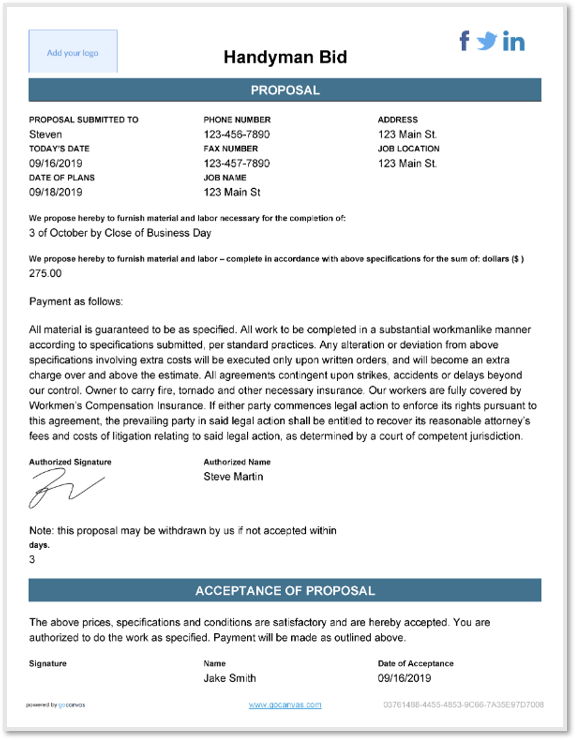Ultimate Guide to Handyman Estimate Templates
Whether you run a property management business or you’re just starting out as a self-employed handyman, nailing down your handyman prices based on the job is vital to your success. Here’s why.
Suppose you price yourself too high, you’ll force potential clients to shop around for estimates from your competitors. On the other hand, if you price yourself too low, either you’ll raise questions about your experience or potential clients will conclude that there’s some sort of catch.
That said, how do you find that sweet spot when pricing your handyman services? Well, continue reading this guide to find out all you should know about the handyman business, including how to price your jobs right.
What Does a Handyman Do?
“Handyman” is an umbrella term for a wide range of jobs and people. A handyman need not necessarily be a man, women can also do the same tasks. We’ll use the term “handyman” in this guide to refer to the entire profession of people with different identities.
So, what kind of services do handymen do? Some standard services include:
- Installation of kitchen cabinets
- Fixing kitchen sinks
- Finding and fixing leaky pipes
- Stair repair and maintenance
- Carpet removal and installation
- Bathroom repairs, improvements, and maintenance
- Basic carpentry tasks
- Attic insulation
- Outdoor repairs and installations such as siding repair, gutter maintenance, and fencing.
Whereas this list is by no means exhaustive, it sets an excellent benchmark for what services a handyman should offer.
What Is a Handyman Estimate Template?
A handyman estimate template is a blank copy of your estimate form, which you can fill out to create a comprehensive estimate after a consultation. These templates can be filled in Microsoft Word, PDFs, Google Docs, Google Sheet Spreadsheets, Excel, handyman estimate software, or even free quoting tools.
You can try out the GoCanvas mobile app for an easy-to-use solution for creating and sending handyman estimates.
PDF Preview | Start Your Free Trial

When Do You Need to Send an Estimate to Customers?
It’s important that you present the prospective client with the estimate in good time. Ideally, you should furnish the prospective client with the estimate within 24-48 hours after meeting or consulting them. This demonstrates that you’re a professional and enthusiastic about the job. Additionally, some clients want things to move fast, so the first submission of the estimate could win the job.
Why Accurate Estimates Are Important for Handyman Businesses and Impact Your Business’s Bottom Line
High-quality workmanship comes at a price. Property renovation and maintenance projects require a substantial amount of time and effort. It is for this reason that every project should begin with an accurate estimate.
An accurate estimate allows you to properly budget for the job at hand, and avoid any rude surprises when it comes to the materials needed to complete the job and the completion timeline. If you don’t present the customer with an accurate estimate of the entire cost of the renovation or project, you may find yourself in a scenario where you’re significantly under-budgeted. This may mean that you may have to absorb the additional costs or find out where you can reduce costs as the project is progressing. When this happens, besides you jeopardizing the quality of the project, this may also impact your revenue negatively.
Conversely, if your estimate is on the higher side, potential customers may opt to work with other handymen who offer the same quality of service at competitive prices. This will mean you’ll have fewer clients, and fewer clients mean lower revenue generation.
How Do I Write a Handyman Estimate? What Should I Include?
There are three ways of creating a written handyman estimate, namely:
- Using a mobile app or software: This is the fastest and easiest method. Creating an estimate using this method takes a few seconds, and you can usually send the estimate right from the app.
- Using Excel: This is the oldest way of writing a handyman estimate. In case you only need to send one or two estimates, this is a simple and free way of sending an estimate.
- Word processor: Google Docs or Microsoft Word can also be used to write estimates. Any word processor can work.
What to Include in an Estimate?
The details you include in your estimate are far more important than the method you use to write or deliver them. Whether you create fancy written estimates or hand-deliver them, the vital components are always the same. They include:
- Description of your work: Ensure that you are ultra-clear about what the estimate covers. In some instances, all you’ll need is a one-line text to describe the work, like “installation of kitchen cabinets.” In other instances, you may need to explain the project extensively.
- Price estimation: You can either itemize everything or quote it in one lump sum.
- Important disclaimers: There are projects that start out small and end up being much bigger. For instance, if you’re going to replace a damaged siding, you may never know what you will find behind the siding. Your estimate is your chance to manage your client’s expectations so that they aren’t met with additional price charges they didn’t see coming.
- Benefits of hiring you: Suppose a potential client is receiving multiple estimates, it’s prudent to find a way of differentiating yourself from your competition. Otherwise, all the customers will use when choosing a handyman is the price quoted.
Components of a Written Estimate
- The details of your company (name, address, email, phone number)
- Customer details (name and address)
- The date the estimate was created
- Project description
- Estimated cost
- Important exclusions and disclaimers
- The expiration date of the estimate
- Terms of payment
- Acceptable payment methods
How Do You Calculate the Price in a Handyman Estimate?
Handyman services usually charge by the hour. However, you can choose to charge by the hour if you feel that it’s a task that you can estimate accurately. That said, it is advisable to set a minimum service charge. This can be something like installing a doorbell or changing a light switch. It’s completely up to you if you want to create a fixed price for small tasks such as these or if you want to set an hourly rate.
Needless to say, the more complex and larger the job, the more you’ll charge per hour. On average, the hourly rate for handyman jobs usually ranges between $60-$65, but jobs that get complex or are part of a larger company can be priced up to $125 an hour.
Another thing you should consider when you’re calculating the price in a handyman estimate is your supplies and materials. Most jobs will require that you come with specific supplies, all of which should be billed to your client. You should also factor in taxes in your pricing estimate.
Given that most handyman jobs aren’t recurrent, it’s likely that you’ll be billing your client once. Keep track of all your expenses and add a markup to ensure that you’re attaining your profit margin.
What’s the Difference Between a Handyman Estimate Versus an Invoice?
An estimate is a rough calculation of the cost of work needed to be done upon initial inspection. Upon a handyman getting into a project, it’s not uncommon that the scope of the work will get expanded. Whether it is due to hidden damages that weren’t assessed or complications during the project, your invoice at the completion may be different from your estimate. An invoice is a bill for the services once a customer hires you for a project. They typically contain itemized costs and terms of payment.
Why Go Digital With Estimates Rather Than Paper Forms
There are many options for creating paper form estimates, including Excel, Word, and Google spreadsheets. Whereas these options are free to use, there are many hidden costs and risks involved when using them. These include:
- Human error: When using paper forms, you can mistype formulas or make other errors and not notice that the final calculation is wrong.
- Version control issues: It can be challenging to keep track of the latest version of a document, especially if you have multiple versions of the same document.
- Lost work: This usually happens accidentally when a computer crashes and the document isn’t saved, or similar cases.
More and more companies are turning to digital forms to create estimates. Digitizing handyman estimates can bring a number of benefits to handyman businesses. Including:
- Secure cloud platform for estimates
- Automatic calculations
- Digital signatures
- Image capturing ability
- Availability of reference data
How Does Estimating Software Work for a Handyman?
Regardless of whether you’re repairing a drywall or installing a new ceiling, a handyman’s job is never finished. With the hectic schedule and the sheer range of services you may offer, a handyman estimating software can help you manage your inventory and eliminate the sleepless nights of handling endless amounts of paperwork.
GoCanvas estimate software for handyman businesses can help convert your paper estimates into efficient digital forms. It simplifies the contract bidding process with its mobile estimating tools that are both easy-to-use and comprehensive.
With our estimating software, you’ll be able to:
- Auto-populate data like prices and parts to minimize manual input and eliminate errors.
- Automatically calculate the cost of labor and materials.
- Store estimates in the cloud so that you can review and update them anytime, anywhere.
Try out our handyman business estimate form mobile app for free.

Stay in Touch!
About GoCanvas
GoCanvas® is on a mission to simplify inspections and maximize compliance. Our intuitive platform takes care of the administrative tasks, freeing our customers to focus on what truly matters – safeguarding their people, protecting their equipment, and delivering exceptional quality to their customers.
Since 2008, thousands of companies have chosen GoCanvas as their go-to partner for seamless field operations.

Check out even more resources

The Ultimate Guide to Quality Control Inspections
Managing a construction project is a complex and stressful process. Among other things, you have to coordinate project team members, materials, and equipment and ensure that contractors are not afflicted by the potential risks and hazards present at the construction site. That said, quality means different things to different people which is why you should…

Constructions Digital Transformation
Your competition is finding faster ways to capture data and get critical insights from the field into their existing systems. In short, they’re not going bigger, they’re getting smarter. In this 15-minute broadcast on the construction industry’s digital transformation, find out why the trend is to modernize workflows – and how you can stay ahead of the curve…

See how VIP Lighting optimized efficiency with GoCanvas
VIP Lighting is a retail lighting and electrical maintenance business that services over 10,000 retail locations all over Australia and New Zealand. Before GoCanvas, VIP Lighting had two separate systems that were impossible to integrate, leading to inefficiencies. GoCanvas made it easy to integrate their systems into single, centralized platform…